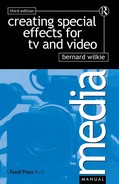Chroma Key: Colour Separation Overlay
These are the names given to an electronic method of combining the outputs from two or more TV cameras or other sources (such as film scanners, etc.). The system allows parts of one picture to be inlaid into another in such a way that the divisions cannot be detected.
The brain of the device is an electronic switch that ‘flips’ over when fed with a certain colour signal from the primary picture. If for instance the control colour is blue, wherever that blue appears in the original scene the switch automatically removes it and substitutes pictures from the second source.
The equipment is highly selective so that only the precise colour hue will trigger the switch, all other tones of the same colour leaving it unaffected.
What it can do
One of its chief assets is that it enables backgrounds to be inserted behind actors without the necessity for a scenic projection system. The actors perform in front of a blue backing and the background scene is supplied either from a transparency scanner or from film on a telecine machine. Alternatively, a second TV camera can be framed up on a picture or photograph in the studio.
Actors dressed in blue performing against a blue backing are invisible. This is useful for those effects where disembodied heads float around or where a person, clothed fully in blue, can manipulate props without being seen. Similarly a flying-carpet can be supported on a framework painted blue and appear to float in the sky.
The chroma key/CSO equipment is often used for caption effects. Letters on coloured backgrounds can be combined with moving film or studio shots to give any variety of effects.
Free-standing cut-outs painted blue can be used to divide the inserted material into layers. This permits actors to work around various components of the inlaid scene. For example, the crates and boxes in a warehouse scene might be no more than sections of profiled plywood coloured blue.
Limitations
Actors placed in front of blue-painted backings are bound to be illuminated from behind with that colour. This leads to coloured fringing which shows against the inserted background. Yellow is sometimes less disturbing than blue for that reason.
Any shiny surface will reflect the colour of the backing, causing break-up of the signal in that area.
Inserted backgrounds remain constant so any movement of the camera taking the primary scene cannot be tolerated.

CHROMA KEY/COLOUR SEPARATION OVERLAY
1. Switching colour
The control colour switches the output from one camera to another.
a, Output from camera 1. b, Output from camera 2. c, Transmitted picture, d, Switching colour, e, Switching unit.
2. Chroma key operation
A number of sources can be combined in one final picture. This is useful for caption effects, but also has application in scenic effects.
1, Telecine film scanner, b, Caption, c, Moving caption in front of backing, d, Performer in front of backing, e, TV camera, f, Switch units, g, Outputs, h, Transmitted picture, k, Cut-out.
